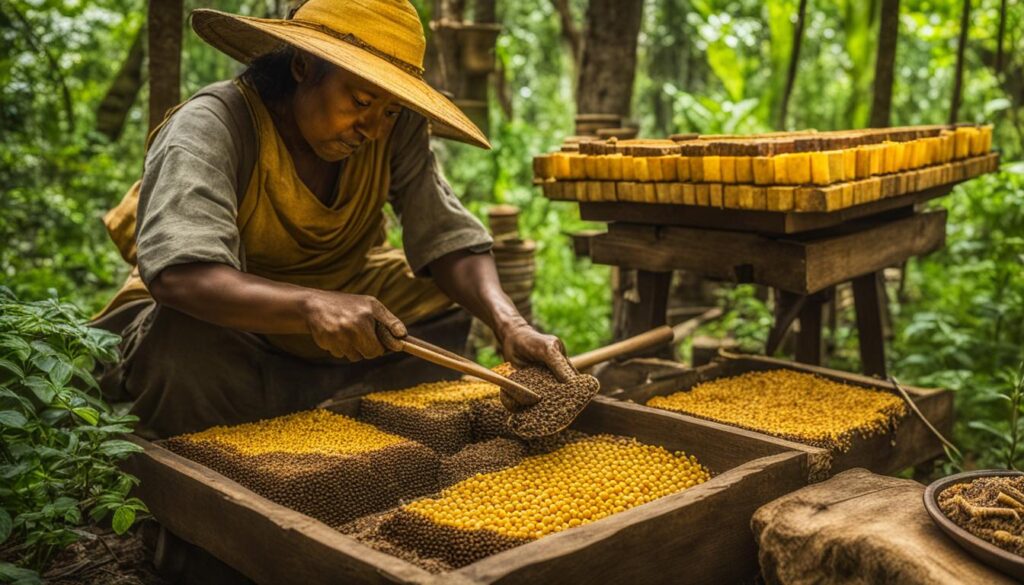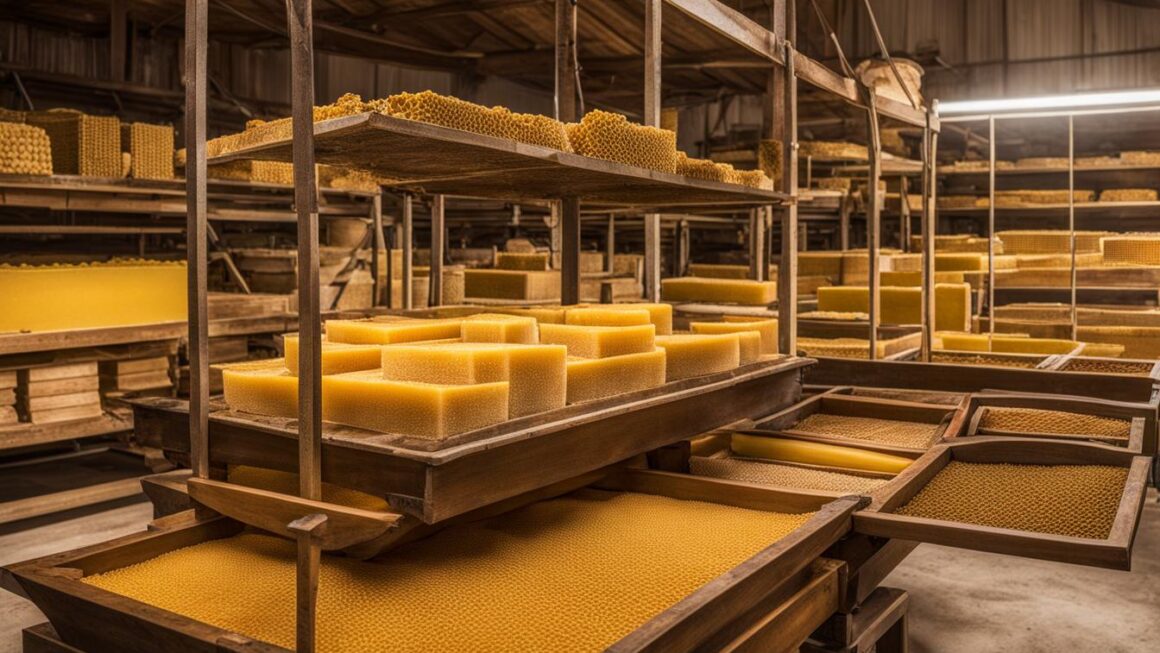Beeswax is a fascinating natural substance produced by honey bees. It has various applications and is valued for its versatility. In this comprehensive guide, we will explore the intricate process of how beeswax is made, from its formation by worker bees to its collection and manufacturing by beekeepers.
Key Takeaways:
- Beeswax is produced by worker bees that are younger than 18 days old.
- The wax starts out colorless and brittle, but becomes pliable after being chewed and mixed with saliva.
- Beekeepers collect beeswax during the honey harvesting process.
- The collected beeswax is melted and filtered to remove impurities, resulting in pure, natural beeswax.
- Beeswax has a wide range of applications, including candle making, skincare, and food preservation.
The Process of Beeswax Collection
Beeswax, a valuable natural substance produced by honey bees, is collected during the honey harvesting process. Beekeepers carefully remove the frames that are full of honey and capped with beeswax. These frames are then taken to a processing area, where the wax is separated from the honey.
To collect beeswax, beekeepers scrape off the beeswax from the honeycomb, exposing the raw honey underneath. This process requires precision and care to avoid damaging the delicate honeycomb structure. The removed beeswax, along with bits of honey, is collected and placed in a centrifuge for extraction.
The extraction process involves spinning the frames in a centrifuge, causing the honey and beeswax to be separated through centrifugal force. As the frames spin, the honey is extracted and collected, while bits of beeswax are left behind. Beekeepers carefully collect and store this collected beeswax, which is then ready for further processing.
Table: Beeswax Collection Process
| Step | Description |
|---|---|
| 1 | Beekeepers remove honey-filled frames capped with beeswax from the beehive. |
| 2 | Beekeepers scrape beeswax off the honeycomb, exposing the raw honey. |
| 3 | Frames with removed beeswax are placed in a centrifuge for extraction. |
| 4 | Centrifuge spins the frames, separating the honey and leaving behind bits of beeswax. |
| 5 | Beekeepers collect and store the collected beeswax for further processing. |
The Many Uses of Beeswax
Beeswax, with its unique properties, has a multitude of applications in various industries. Let’s explore some of its most common uses:
1. Beeswax Candles
Beeswax is highly regarded for its use in candle making. Beeswax candles burn longer and brighter than candles made from other waxes. They emit a subtle, natural aroma that adds a warm ambiance to any space. The natural composition of beeswax ensures a cleaner burn with minimal soot or smoke.
2. Beeswax Lubricant
Due to its low melting point and smooth texture, beeswax is an excellent lubricant. It can be used to reduce friction and provide long-lasting lubrication for various applications. From door hinges to sewing machine mechanisms, beeswax lubricant ensures smooth operation and prevents wear and tear.
3. Beeswax Skin Products
Beeswax is a common ingredient in skincare products due to its moisturizing and protective properties. It forms a natural barrier that helps retain moisture, making it ideal for lip balms, hand creams, and lotions. Beeswax-based skincare products provide nourishment, hydration, and protection for the skin, leaving it soft and supple.
Whether it’s creating beautiful candles, ensuring smooth machinery operation, or nourishing the skin, beeswax is a versatile natural resource with numerous potential applications.

| Application | Benefits |
|---|---|
| Beeswax Candles | Burn longer and brighter, emit a natural aroma |
| Beeswax Lubricant | Reduces friction, provides long-lasting lubrication |
| Beeswax Skin Products | Moisturizes, protects, and nourishes the skin |
Beeswax in History and Culture
Beeswax holds a significant place in human history, with its use dating back to ancient civilizations. The historical significance of beeswax can be traced through various cultures and its diverse applications in both symbolic and practical contexts.
Ancient Civilizations and Beeswax
In ancient Egypt, beeswax played a crucial role in religious rituals and mummification. Egyptians believed that beeswax represented the sun god Ra and used it in offerings to deities. Beeswax was also utilized in the preservation of bodies during the mummification process, ensuring the eternal journey of the deceased.
Similarly, in ancient Rome, beeswax held great importance. The Romans used beeswax in religious ceremonies, as well as for medicinal and cosmetic purposes. Beeswax was a key ingredient in ointments, perfumes, and makeup, highlighting its valued role in daily life.
Beeswax in Medieval Times and Beyond
During the medieval period, beeswax found its way into the realm of literature and art. It was used in the production of illuminated manuscripts, where scribes would inscribe text on parchment and embellish it with vibrant illustrations using beeswax-based paints. This application of beeswax showcased its versatility as a material that could enhance both the durability and aesthetic appeal of manuscripts.
Furthermore, beeswax continued to hold importance in traditional medicinal practices. It was utilized in various remedies and salves due to its antimicrobial properties and skin-protective qualities. The natural characteristics of beeswax made it a valuable ingredient in the field of medicine.
Overall, the historical significance of beeswax is deeply intertwined with the cultural practices and beliefs of ancient civilizations. From religious rituals to artistic expressions and medicinal uses, beeswax has left an indelible mark throughout history.

Chemical Composition of Beeswax
Beeswax, a natural substance produced by honey bees, has a complex chemical composition that contributes to its unique properties and applications. Primarily composed of esters, beeswax is known for its solidity and durability. These esters give beeswax its characteristic structure, making it malleable and adhesive when heated. Additionally, beeswax contains fatty acids, which further enhance its malleability and provide a smooth texture.
Aside from esters and fatty acids, beeswax also contains hydrocarbons, which play a crucial role in its flammability. These hydrocarbons make beeswax an ideal material for candle production as they facilitate combustion. The presence of these hydrocarbons contributes to the bright and long-lasting flame of beeswax candles.
The chemical composition of beeswax, with its combination of esters, fatty acids, and hydrocarbons, makes it a versatile substance with diverse applications. From candle making to skincare products, beeswax’s unique properties have been utilized for centuries. Understanding its chemical composition allows for a deeper appreciation of its remarkable qualities.
Chemical composition of beeswax:
| Component | Chemical Name |
|---|---|
| Esters | Beeswax Esters |
| Fatty Acids | Beeswax Fatty Acids |
| Hydrocarbons | Beeswax Hydrocarbons |
Diverse Applications of Beeswax
Beeswax is a versatile substance that finds its way into various applications, ranging from candle making to skincare and even food preservation. Its natural properties make it a popular choice in these diverse fields.
Beeswax Candle Making
One of the most well-known uses of beeswax is in candle making. Beeswax candles have gained popularity due to their natural aroma and longer burn time compared to other types of candles. They provide a warm and inviting atmosphere, making them a favorite for both decorative and functional purposes.
Beeswax Skincare
Beeswax is a valued ingredient in skincare products. Its skin-protective and moisture-retentive qualities make it beneficial for moisturizing and nourishing the skin. Beeswax-based balms, lotions, and lip balm are popular choices among those seeking natural and effective skincare solutions.
Beeswax Food Preservation
As a natural alternative to plastic wrap, beeswax can be used for food preservation. Beeswax wraps, made by coating fabric with beeswax, can be used to cover bowls, wrap sandwiches, or keep fruits and vegetables fresh. These wraps are reusable, eco-friendly, and help reduce single-use plastic waste.
Beeswax in Industrial Applications
In addition to its applications in candles and skincare, beeswax is also utilized in various industrial sectors. Its lubricating and protective properties make it suitable for use in pharmaceuticals, electronics, and other manufacturing processes. Beeswax ensures smooth operation and prolongs the lifespan of machinery and equipment.
| Applications | Description |
|---|---|
| Beeswax Candle Making | Used for making environmentally-friendly and long-lasting candles with a natural aroma. |
| Beeswax Skincare | Incorporated into balms, lotions, and lip balms for moisturizing and protecting the skin. |
| Beeswax Food Preservation | Used as a natural alternative to plastic wrap for preserving food freshness and reducing plastic waste. |
| Beeswax in Industrial Applications | Utilized in various industrial sectors for its lubricating and protective properties. |
These diverse applications highlight the versatility and value of beeswax as a natural resource. From creating a warm ambiance to nourishing the skin and even aiding in food preservation, beeswax continues to find its place in various industries and everyday life.
Challenges of Beeswax Adulteration
The increasing demand for beeswax has given rise to the concerning issue of adulteration, where cheaper waxes or other substances are mixed with beeswax. This poses significant challenges in terms of product quality, purity, and the livelihoods of beekeepers. Adulterated beeswax can compromise the integrity and authenticity of various beeswax products, impacting consumer satisfaction and trust in the industry.
One of the main issues with beeswax adulteration is the difficulty in detecting it. Adulterated beeswax can closely resemble pure beeswax in appearance, making it challenging for consumers and even experts to distinguish between the two. This can lead to unknowingly purchasing lower quality products or paying higher prices for adulterated beeswax.
The consequences of beeswax adulteration are far-reaching. For beekeepers, it undermines their hard work and expertise in producing pure beeswax, affecting their reputation and income. It also disrupts the integrity of the entire supply chain, as adulterated beeswax can find its way into various industries and applications, including cosmetics, candle making, and pharmaceuticals.
The Impact of Beeswax Adulteration:
- Product quality and purity may be compromised.
- Consumer trust and confidence in the industry may be undermined.
- Beekeepers’ livelihoods and income may be affected.
- The entire supply chain may be disrupted, impacting various industries.
Beeswax adulteration is a serious issue that requires vigilance and regulation to safeguard the quality and authenticity of beeswax products. Consumers can play a crucial role by being aware of the potential risks and choosing trusted sources for their beeswax needs.
Efforts are underway to address the challenges of beeswax adulteration. Regulatory bodies and industry associations are working together to establish and enforce quality standards and certifications for beeswax. These measures aim to ensure that consumers have access to genuine, high-quality beeswax products while supporting beekeepers in their sustainable practices.
As consumers, it is important to be informed and make conscious choices when purchasing beeswax products. By supporting reputable beekeepers and manufacturers who prioritize quality and transparency, we can contribute to the preservation of this valuable natural resource and the sustainability of the beekeeping industry.
Recent Scientific Revelations about Beeswax
Recent scientific research has uncovered fascinating discoveries about the medicinal properties of beeswax. Studies have shown that beeswax possesses anti-inflammatory and antimicrobial effects, making it a potential candidate for various medical applications. Its anti-inflammatory properties make it effective in reducing inflammation and soothing irritated skin. Additionally, its antimicrobial effects can help inhibit the growth of bacteria and fungi, making it valuable for wound healing and preventing infection.
Beeswax is also gaining recognition as a sustainable material with a wide range of applications. As an environmentally-friendly alternative to synthetic materials, beeswax offers biodegradability and a reduced ecological footprint. It can be incorporated into various products, such as natural cosmetics, organic textiles, and eco-friendly packaging. By utilizing beeswax as a sustainable material, we can reduce our dependence on non-renewable resources and contribute to a greener future.
In summary, recent scientific revelations have shed light on the remarkable properties of beeswax. Its anti-inflammatory and antimicrobial properties make it a promising ingredient for medicinal applications, while its sustainability makes it an attractive choice for eco-conscious consumers. As we continue to explore the potential of beeswax, it is clear that this natural substance holds great promise in both the medical field and the pursuit of sustainable materials.
| Medicinal Properties of Beeswax | Sustainable Materials Using Beeswax |
|---|---|
| Anti-inflammatory effects | Biodegradable cosmetics |
| Antimicrobial properties | Eco-friendly textiles |
| Wound healing | Environmentally-friendly packaging |
Conclusion
Beeswax is truly a remarkable natural resource, with a fascinating production process and a multitude of applications. From the secretion of specialized glands by worker bees to its collection and processing by beekeepers, the creation of beeswax showcases the intricate labor of these remarkable insects.
Beeswax plays a vital role in beekeeping, serving as the building blocks of hives and providing the structure for honeycomb and the storage of honey. Without beeswax, the honey production and management process would be significantly compromised.
Furthermore, the versatility of beeswax is evident in its many uses. From the creation of long-lasting and fragrant candles to its inclusion in skincare products for its moisturizing and protective properties, beeswax has found its way into various industries for its beneficial qualities.
In conclusion, the importance of beeswax cannot be overstated. Its rich history, intricate production process, and wide-ranging applications make it a valuable natural resource that deserves recognition and preservation. As we continue to explore the scientific revelations and technological advancements associated with beeswax, it is crucial to appreciate the vital role it plays in beekeeping and the many benefits it provides to our lives.
FAQ
How is beeswax made?
Beeswax is made by worker bees that are younger than 18 days old, as they have specialized glands that secrete the wax. The wax starts out colorless and brittle, but becomes pliable after being chewed and mixed with saliva.
How is beeswax collected?
Beeswax is collected during the honey harvesting process. Beekeepers remove the frames that are full of honey and capped with beeswax. The wax is then scraped off the honeycomb, exposing the raw honey. The frames are placed in a centrifuge that extracts the honey along with bits of beeswax. The collected beeswax is melted and filtered to remove impurities, resulting in pure, natural beeswax.
What are the uses of beeswax?
Beeswax has a wide range of applications. It is commonly used for making beeswax candles, as it burns longer and brighter than other waxes. Beeswax can also be used as a lubricant and is an ingredient in various skin products. Its natural properties make it beneficial for moisturizing and protecting the skin.
What is the historical significance of beeswax?
Beeswax has played a significant role in human history. Ancient civilizations, such as the Egyptians and Romans, revered beeswax for its symbolic and practical uses. It was used in mummification rituals and as offerings to deities. Beeswax was also utilized in medieval manuscripts and found its way into traditional medicinal practices.
What is the chemical composition of beeswax?
Beeswax is primarily composed of esters, which give it its solidity and durability. It also contains fatty acids that contribute to its malleability and adhesive properties. Beeswax contains hydrocarbons, which make it flammable and suitable for candle production.
What are the diverse applications of beeswax?
Beeswax has diverse applications. It is commonly used in candle making, as beeswax candles have a natural aroma and longer burn time. Beeswax is also a valued ingredient in skincare products due to its skin-protective and moisture-retentive qualities. It can be used for food preservation as well, serving as a natural alternative to plastic wrap. Beeswax is also utilized in various industrial applications, such as pharmaceuticals and electronics, thanks to its lubricating and protective properties.
What are the challenges of beeswax adulteration?
The demand for beeswax has led to concerns of adulteration. Adulterated beeswax, mixed with cheaper waxes or substances, poses challenges regarding product quality, purity, and the livelihoods of beekeepers. Ensuring the authenticity and quality of beeswax has become an important issue in the industry.
What recent scientific revelations have been made about beeswax?
Recent scientific research has revealed several intriguing facets of beeswax. It has been found to have anti-inflammatory and antimicrobial properties, leading to potential medicinal applications. Beeswax is also being recognized as a sustainable alternative to synthetic materials, providing biodegradability and a reduced ecological footprint.
What role does beeswax play in beekeeping?
Beeswax is a remarkable substance with a rich history and wide-ranging uses. Its production process, from the secretion by worker bees to its collection and processing by beekeepers, showcases the intricate labor of bees. Beeswax plays an essential role in beekeeping, serving as the building blocks of hives and facilitating honey production and management. Its valuable properties and diverse applications make beeswax a truly remarkable natural resource.




